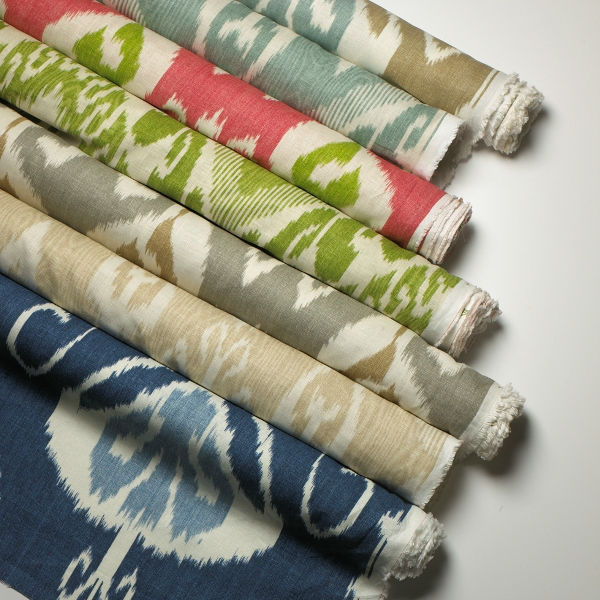
Bansuri, a popular ikat from Echo Design, shown here in multiple colorways
Alice Guercio the Vice President of Product Coordination at Kravet answers your questions about Ikat Fabrics
One of the most popular trends in interior design today is ikat. The word ikat comes from the Malaysian word ‘mengikat’ or to tie, bind or wrap around. The proper pronunciation of the word has long been debated; however, the correct way to pronounce is ‘ee-kaht’ not ‘eye-cat.’ This ancient style of weaving uses a resist dyeing process similar to tie-dye where the warp and/or the weft yarns are dyed before the fabric is woven on the loom. The result of this process is a motif which is “blurred” in appearance. This ‘cloudy’ look comes from the slight bleeding of the dyes into the resist areas.
Click here to hear how to pronounce “Ikat”
Ikat is a universal weaving style common to many world cultures and is likely to be one of the oldest forms of textile decorations now. It is extremely difficult to determine where the technique originated. It probably developed in several different locations independently. For instance, during the 19th century, the Silk Road deserts of Bukhara and Samarkand were famous for their fine silk Uzbek Ikat. India, Japan and many South-East nations such as Cambodia, Myanmar, Philippines and Thailand have weaving cultures with long histories of ikat production. In addition, these designs were also common in Argentina, Bolivia, Ecuador, Guatemala and Mexico.

Ikat couch done in Dwell Studio Batavia Ikat Citrine Photo From Design Gush
The ikat design is created by tying areas of the threads into bundles using grasses, wax or even plastic to prevent penetration of the dye. What this means is the weaver needs to figure out where on the loose threads the dye should go in order for it to form the proper pattern when it is woven. For more exact patterning, a weaver will typically use warp ikats, where they can see the pattern on the loom. With a weft ikat, the pattern is less exact because the design is not visible until it is already woven. The most difficult is the double ikat. This is when both the warp and weft are dyed to create the pattern. This form of weaving requires the most skill for precise patterns to be woven and it is considered to be the highest form of ikat. As you add colors, the process becomes more complicated.
Many design motifs may have ethnic, ritual or symbolic meaning. Traditionally, ikats are symbols of status, wealth, power and prestige. Today, ikat has become a generic word used to describe the process, the cloth itself and the type of motif that is created as a result.

El Convento Mesa Ikat Print by Nate Berkus
Check out Kravet’s Blog for the rest of the article and to see the video of how Ikat is made.
Find more Ikat fabrics at Housefabric.com